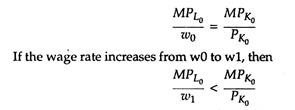The following article will guide you about how a rational firm will respond to a change in input prices.
A firm’s optimal employment of inputs depends upon the prices of the inputs. In fact, when the price of an input changes, the manager will have to react if he is to continue minimising the cost of producing a given output. Suppose that the firm has minimised costs and is operating where at the initial cost-minimising position.
That is, an increase in the wage rate causes the additional output resulting from spending Rs. 100 more on labour to be less than the additional output resulting from spending Rs. 100 more on capital. This gives the firm an incentive to substitute away from labour and toward capital.
ADVERTISEMENTS:
This can also be seen graphically. In Fig. 10, the firm initially minimised the cost of producing Q0 by using L0 units of labour and K0 units of capital on isocost AB. An increase in the wage rate makes all of the isocosts steeper. If expenditures on inputs stay at the same level C0, the intercept of the isocost on the capital axis (C0/PK0) would be unchanged.
An increase in the wage rate of labour from w0 to w1 would thus rotate the isocost about its capital axis intercept from AB to AD. As can be seen, fewer inputs can now be purchased as a result of the increase in labour’s price. Moreover, none of the input combinations along AD is sufficient to produce Q0. The firm will simply have to spend more money if it is to maintain production at the Q0 level.
Any additional expenditure on inputs entails moving to a higher isocost that is parallel to the new AD isocost. If the manager elects to produce Q0 with the old combination of inputs, L0 and K0, he will spend C1 rupees on isocost line, A’ B’. But this old combination of inputs no longer minimises costs.
ADVERTISEMENTS:
The new cost-minimising combination is K1 and L1, which is found where isocost A” D” is tangent to the Q0 isoquant. Thus, we can see that the wage increase caused the firm to substitute away from labour and toward capital in the production of Q0 units of output. In this case, K1 – K0 units of capital are substituted for L0 – L1 units of labour.
There are thousands of examples of input utilisation responding to input prices. Industrially advanced countries relies more on machines and less on labour than is the case in the developing countries, where wages are low. Book-keeping is done by computer in high-wage countries and manually in low-wage countries. Furthermore, as computers have fallen in price over time, there has been a substitution away from the labour toward capital (i.e., computers). Land is utilised more intensively when it is more expensive.

